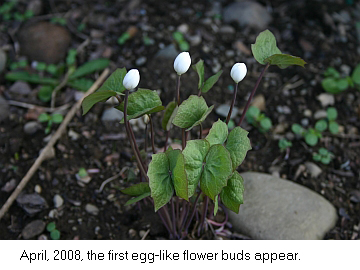Green Butterflies (Twinleaf)
April 2008
I'm excited to write this article for several reasons. Foremost is that twinleaf is flowering for the first time in my garden. It took four years from seed to bloom, but several articles report it taking up to eight years before flowering.
The common name refers to its paired leaflets that resemble butterfly wings, both open and shut. The Latin name was bestowed by the famous botanist Benjamin Smith Barton to honor Thomas Jefferson, at a meeting of the American Philosophical Society on May 18, 1792 - a meeting that Jefferson did not attend.
Like many of our spring ephemerals, twinleaf seeds need multiple periods of alternating cold and warm periods before they will germinate. This requirement, called stratification, is carried out by nature to ensure that our early wildflowers do not germinate prematurely during that first warm spell in April when a later May frost may kill the young seedlings. If the seeds are not fresh enough, they may not grow. Once germinated, however, twinleaf will readily thrive and spread in rich soil with a shady habitat. They naturally like rich, deciduous woods, but mine is in a small garden bordering my back deck where it only receives the morning sun. If you'd like to see this plant in bloom, perhaps the best place to visit is the Mundy Wildflower Garden at Cornell Plantations. It flowers there beginning in mid-April. Better yet, purchase some seeds or plants and plant them in your own garden where you'll have your own welcomer of flowers to come.About
By Joe O'Rourke
Photos by Joe O'Rourke
Plants Referenced
Common Name(s):
Twinleaf
Bloom Time:
Mid Spring
Moisture:
Dry
Moist
Light:
Shade
Soil:
Humus-rich Woodland
ph Preference:
Neutral
Showy fruit
Groundcover







